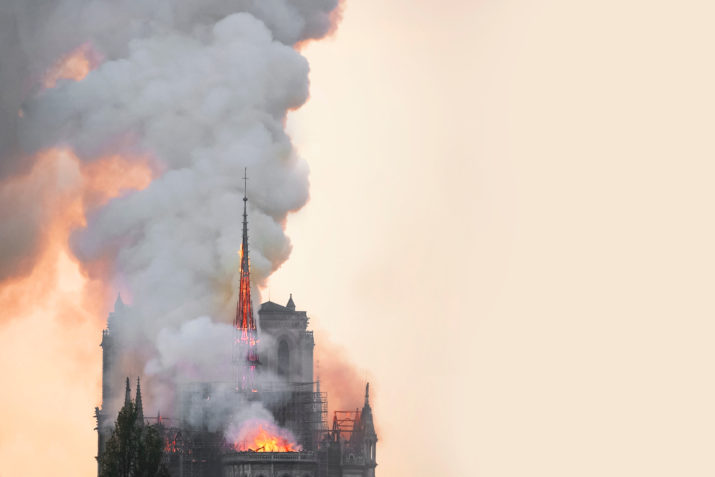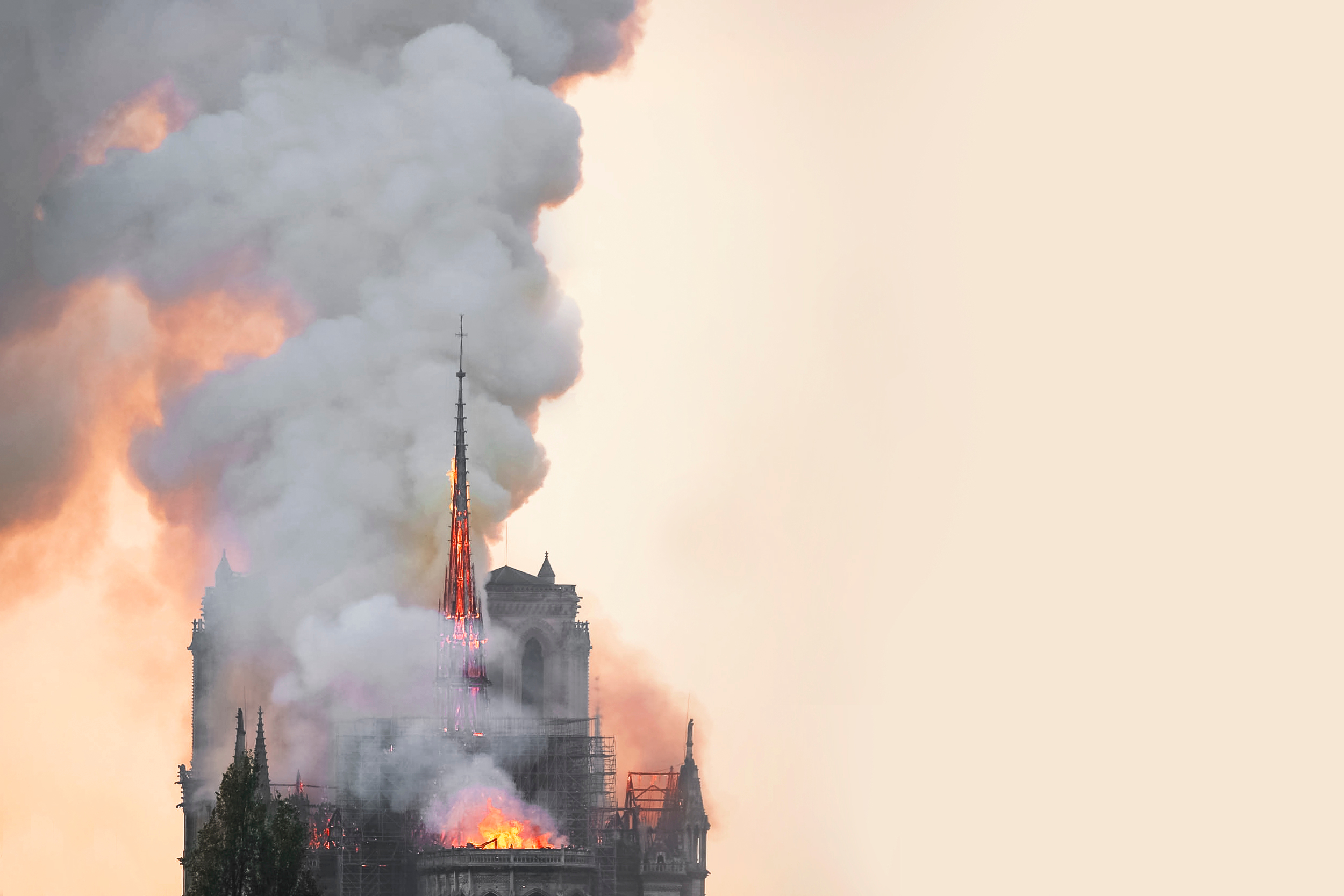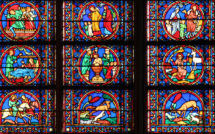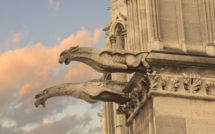

This is part of a roundtable on Notre-Dame de Paris.
The fire of April 15, 2019 at Notre-Dame became a terrible lesson in Gothic architecture, about monumental medieval churches built of wood and stone. The public learned that hidden between the vaults and the lead plates of the roof there is (was) a vast and invisible “forest” of timber, a framework of oak trusses suspended on the uppermost walls of the cathedral. The wood in the roof was ancient; some of it in place since the choir was consecrated in 1182 and others put in place after Bishop Maurice de Sully left a legacy for further construction of the roof in 1196. For over eight hundred years, this wood has been exposed to great heat in the summer, and to frigid temperatures in the winter. It was old, dry oak, perfectly ready for a conflagration. The wooden framework also included supports for the spectacular spire erected by the nineteenth century architect, Eugène Emmanuel Viollet-le-Duc, who restored the cathedral after the depredations of the French Revolution and its aftermath in the following decades. This April, during that terrible afternoon, we saw the flaming spire tilt and crash through the vaults, which caused the worst damage to the interior of the church.
The stone with which a cathedral is built doesn’t burn. In fact, scholars have theorized that one of the reasons for using stone in medieval architecture was precisely in order to fireproof buildings. But stone is damaged by fire: intense heat makes it friable—it cracks and breaks, and eventually turns to powder (this is how powdered lime for concrete and plaster, as well as for gardens, is produced). The stones at Notre-Dame Cathedral that received the brunt of the intense heat are those in the uppermost parts of the building—the vaults and the upper walls adjacent to the fire in the roof. In these upper parts of the building, there will need to be a careful, stone-by-stone assessment of the condition and continued viability of each piece. Since Gothic structures depend on a stable balance between the thrust and counterthrust of the vaults and flying buttresses in the uppermost parts of the building, these buildings are in equilibrium only when all the elements are complete and intact. Relative to the weight of the vaults, the upper walls are thin, but the integration of the flying buttresses made it possible to void out large sections of the upper walls for great glass windows. The stability of a Gothic building depends upon a state of tension that is kept in equilibrium by the relationship between the vaults and the flyers.
How will an assessment of the condition of the upper walls and vaults be achieved? Imagine that above the vaults there is now a congealed “soup” of massive burned timbers, wood ash, and melted lead from the roof. How will that nasty mix of materials be removed? Because of the possible fragility of the upper parts of the building, a massive superstructure now “hovers” over the cathedral, a great metal frame perched above the vaults from which workers dangle like spiders from a web to remove the ash, timber and melted lead. Only when the upper surfaces of the stone vaults have been cleared, and the condition of each stone (as well as the mortar between them) can be analyzed, will it be possible to fully understand how extensive the repairs to the dangerously calcined stone elements will need to be.
The wooden framework and lead plates of a Gothic roof protect a cathedral from the elements. Yet, once complete, the roof also becomes one of the most vulnerable points of a cathedral. It is a potential victim of fire from lightning, bad electrical connections, cigarette butts, or whatever else might go amiss. Early in the twentieth century, bombardments in eastern France during the First World War set fire to a number of cathedrals (Reims, Noyon, Soissons, St.-Omer). In the Second World War, Allied bombings set fire to churches and historic buildings throughout Normandy, Germany, Poland, and southern Italy; the televised images from the fire of April 15th may have brought back nightmares to those few who may still be alive from that dreadful period.
At Notre-Dame, the gray-green expanse of the lead roof is now gone, and we’re suddenly conscious of how important its clean smooth lines were for the exterior “persona” of the cathedral: the roof was a “cap” that calmed and resolved the complex jumble of windows, gables, pinnacles, and flying buttresses below. Since the roof of a cathedral rises thirty to fifty feet above the vaults (at Notre Dame the vaults are 33 meters—roughly 108 feet—above the pavement), it heightened the exterior visibility of this great church, creating a powerful affirmation of the centrality of religion in a medieval city. From the outside, the surface of the roof of Notre-Dame and the great west towers were designed to generate maximum visual impact from everywhere in Paris and the Seine, especially from the right and left banks of the river. I imagine that the strong smooth lines of that beautiful roof, now gone, have been loved since the completion of the church in c. 1250, and prior to the nineteenth century, of course, the upper profile of the cathedral was far more visible from the countryside than it is today. When we dream of Paris, we dream of Notre-Dame soaring above the Ile-de-la-Cité on the Seine.
How do I know this building so well? In the early 1980s, the interior of the cathedral was being cleaned, a process that entailed the erection of scaffolding up its entire height to the vaults. Over a period of roughly six years, the scaffolding was gradually moved from the east (altar) area to the entrance at the west. I happened to be living in Paris at the time, on a grant from the National Endowment for the Humanities, writing a book on the church of Saint-Denis in the thirteenth century, and when I discovered that no other scholar was taking advantage of the scaffolding to study the upper walls of the cathedral, I began to do so, which meant following the work of the cleaners over a seven year period. I measured the dimensions of the stones, recorded molding profiles, all part of a process of trying to unravel the story of the long period of its construction. When my grant was over, I returned to teaching at Duke University, taking advantage of the direct flights from Raleigh-Durham to Paris to continue my work: I would teach Friday morning, take the evening flight to Paris, work all day on Saturday, and return home on Sunday to meet my classes on Monday. In the last phases of the cleaning, my infant son came with me, in what was then called a “snuggly,” up the hundred feet of scaffolding (the kind of thing that working mothers do). During those many years of measuring and recording everything that I could measure, my interest was in whether, in the absence of written documents, the stones themselves could help us understand how the cathedral was erected and how the design was modified and modernized during the process of construction. As a result of this research, and as explained in a long article published in 1987, the cathedral was modified many times during the long course of its construction: the design evolved and numerous changes (or improvements) were introduced. As a result of the stone by stone analysis that could be done only from the scaffolding, I proposed that the cathedral was on some level a monument “in dialogue,” not only with itself, but with the other more recent, more “modern” structures that were being erected everywhere in the Ile-de-France.[1]
Fires were the scourge of Medieval and Early Modern buildings and cities (think of the Great Fire of London, 1666). But they were also the opportunity for great creativity and innovation, an incentive to introduce new updated architecture and to produce cities built largely of non-flammable materials (London, Paris). In the Middle Ages, some cathedrals burned over and over (Canterbury, Chartres, Reims), but the destruction of the old churches stimulated the construction of the glorious structures in the Gothic style that we know today. Almost always, the disaster of a fire enabled communities to build larger and taller buildings; they also provided an opportunity to quest for funds, to promote the relics, to draw attention to the importance of a place. And this is also happening today: there are paper models of the cathedral to be purchased on Facebook. In Paris, shops (including those at Roissy and Orly airports) have designated credit card terminals for donations.
For those who were near Notre-Dame on April 15th, and for the rest of the world watching on television, the fire brought forth a surge of emotion and anguish. It was a terrible thing to see. Nothing could remind us more vividly of medieval experience than the description of the fire of 1174 at Canterbury Cathedral as recounted by the twelfth-century monk Gervase (c. 1141- 1210): “The people were astonished that the Almighty should suffer such things, and maddened with an excess of grief and perplexity, they tore their hair and beat the walls and pavement of the church with their heads and hands, blaspheming the Lord and His Saints…. and many, both of the laity and monks, would rather have laid down their lives than that the church should have so miserably perished.”[2] Similarly, at Chartres, where the fire damaged not only the cathedral, but also much of the town, the inhabitants, “whose homes and practically all their furnishings the fire had consumed, all deplored the destruction of the church to such an extent that they made absolutely no mention of their own losses; they considered as their chief misfortune, or rather the totality of their misfortune, the fact that they, unhappy wretches, had lost the place of the Blessed Virgin, the special glory of the city, the showpiece of the entire region, the incomparable house of prayer.”[3]
As at Notre-Dame last April, medieval narratives about fires also and often include accounts of the miraculous rescue of sacred relics: an affirmation of divine grace even at a time of profound grief and collective anguish. The rescue of the relics at Notre-Dame repeated this ancient trope. At Canterbury, after the flames were put out, the monks erected temporary altars within the church in order to continue religious services and to maintain the active spiritual presence of the saints: “…(the monks) put together as well as they could an altar and station in the nave of the church, where they might wail and howl, rather than sign, the services.” Gervase went on to note the following: “Meanwhile, the patron saints of the church, St. Dunstan and St. Elfege, had their resting place in that wilderness. Lest, therefore, they should suffer even the slighted injury from the rains and storms, the monks, weeping and lamenting with incredible grief and anguish, opened the tombs of the saints and extricated them in their coffins from the choir, but with the greatest difficulty and labor, as if the saints themselves resisted the change.” Gervase’s text brings up another essential point. Religious services had to continue for both the monastic community and the laity. A provisional church needed to be set up in the undamaged part of the building, the nave. It may be that at Notre-Dame, once the condition of the structure has been understood, it will be possible to use one of the side aisles for Masses (with all sorts of protective barriers) until the entire church can become accessible and return to its normal liturgical rhythm.
Fires were thus disruptive, traumatic, and emotional events. They were frequent in the Middle Ages and Early Modern periods, their devastation fearful to behold and challenging to repair. But if building in stone was a way of fireproofing monumental architecture, what we saw in the Notre-Dame conflagration of April 15th was in fact a demonstration of just this, a “proof of the pudding:” the fire showed us that the stone vaults were indeed largely effective in protecting the remainder of the building from complete destruction. Without the stone vaults as a kind of firewall, the events of April 15th could have been far worse. And, as we all saw, the worst damage occurred when Viollet-le-Duc’s flaming spire pitched to the side and collapsed through the vault to the crossing below. The explosion of lead and ashes could have set the choir stalls on fire, and damaged much of the internal sculpture (especially that of the medieval choir screen), but for the most part the fire inside the church seems to have been quickly contained. A few other vaults were destroyed or damaged by the weight of the burned and burning timbers collapsing onto and through their upper surfaces, but again, damage inside the church seems to have been limited. It is important to remember, however, that the situation is still potentially highly unstable: if further vaults collapse, the thin upper walls of the cathedral, under pressure from the flying buttresses on the exterior that push inwards to counteract the thrust of the vaults, might push the upper walls towards the interior, generating collapse of the upper structure. Because of the danger posed by possible further collapses of vaults or the upper walls, only robots are used within the nave of the church.
The restoration of Notre-Dame will require extensive technical expertise on how to stabilize the existing structure and remove the damaged portions, a process that needs to follow a delicate choreography of stabilization through scaffolding and struts, and a massive clean-up of the debris, prior to the beginning of reconstruction. Every single part of the upper walls and vaults necessitates careful assessment in order to ascertain how much can be preserved and what will need to be replaced with new stone. There will need to be considerable reflection and discussion on how to build, with which materials, and in what sequence. Again, Gervase’s account from Canterbury seems exquisitely apropos, for he tells us how the “pillars of the church were exceedingly weakened by the heat of the fire, and were scaling in pieces and hardly able to stand, so that they frightened even the wisest out of their wits.”[4] At Canterbury, the religious community was deeply attached to the old choir (remember that a monk makes a life-long commitment, often from adolescence until death), and when the consulting master builder suggested that the whole church must be pulled down, they were “excruciated with grief.”[5] Much patience and diplomacy was to be required on the part of the master builder, William of Sens, “who concealed for some time what he found necessary to be done, lest the truth should kill them (the monks) in their present state of pusillanimity.”
But nowadays, where will masons with the requisite stone-cutting skills come from? Many cathedrals, such as the National Cathedral in Washington, have a standing team of masons skilled in historic techniques of stone carving and the elaborate stereotomy required for the ribs and vault surfaces. It may be that their services, and those of other teams of masons elsewhere, can be borrowed for a time. Even once the site is cleared and cleaned, and the damage assessed, restoration of the scale required for Notre-Dame will require many workers for many years. This may be an opportunity to train a new generation of young people in stone cutting techniques and historic construction methods, but that too will require substantial lead time while a new working team of masons are able to make serious and skilled contributions to the fabric of the building.
And where also will they find the dense and fine-grained limestone for the reconstruction? Paris was fortunate to be located at the center of the great limestone plateau of central France, the Ile-de-France, but the quarries that were used for Notre-Dame and most other medieval buildings in the city were located under the city itself, in areas into which the city and its suburbs have now expanded. Another question will be finding supplies of massive timbers for the roof, if the decision is made that this should be the material used in its reconstruction. The beams of old wooden framework had been cut by hand, following the grain of the wood, and this gave the structure some elasticity, an important feature when the high expanse of the roof is under pressure during windy conditions. Can new, machine-cut wood, if that is what will be eventually chosen, do the same?
Yet as with fires in the past, there is also good news. As at Chartres, as at Canterbury, and as at so many other medieval cathedrals, Notre-Dame in Paris will be rebuilt, and The French Senate decreed on May 27 that the cathedral should be restored as it was prior to the fire, with the use of as many original materials as possible. It will be fascinating to see how the complex challenges of the restoration will be resolved through the use of modern technologies. Let us hope that the final result will be visible in our time.
Caroline Bruzelius is a scholar of medieval architecture and sculpture in Italy and France. She has published extensively on Gothic buildings, and taught at Duke University from 1981 to 2018. Between 1994 and 1998 she was Director of the American Academy in Rome. She now lives in Cambridge, Massachusetts.
References:
[1] Caroline Bruzelius, “The Construction of Notre-Dame Cathedral,” The Art Bulletin, Vol. 64, n. 4, 540-569.
[2] A translation of Gervase’s text can be found in Terese G. Frisch, Gothic Art 1140-c. 1450. Sources and Documents (Toronto, Buffalo, London: University of Toronto Press, 1971), 37.
[3] The text is from The Miracles of the Virgin, translated by Robert Branner, Chartres Cathedral (Norton Critical Studies in Art History), (New York, W.W. Norton and Company, 1971), 95
Photo: Fire sweeps through Notre Dame Cathedral (Paris, France) on April 2019 | Shutterstock
Published on October 2, 2019.




